Abstract
Infectious cellular uptake of human immunodeficiency virus (HIV) is initiated by a complex sequence of interactions between the viral envelope gp120/gp41 complex and the cellular CD4 receptor resulting in the exposure of a hydrophobic region of gp41 that mediates the irreversible fusion of the virus with the cell membrane. Here we show that viral penetration into a susceptible cell can be inhibited by the high-affinity monoclonal CD4 antibody (CD4 mAb) M-T413 even when it is added as late as 30-120 min after the initial contact of virus with the cell membrane. Inhibition of infection was assessed by monitoring cultures for 34 days after exposure to virus using four different methods simultaneously, including detection of viral DNA by PCR. The interval during which HIV remains sensitive to postbinding neutralization by CD4 mAb depends on strain of virus and type of target cell. Preparations of recombinant soluble CD4 (and the immunoadhesin CD4-IgG1) were much less efficient when compared with mAb M-T413, particularly in blocking infection by fresh HIV-1 isolates. Also cellular transmission of HIV, as determined by syncytia formation within 24 hr, was prevented by mAb M-T413 when added within 45 min of contact of infected H9 cells with uninfected C8166 cells. Together with the favorable clinical experience obtained with CD4 mAbs as immunomodulatory drugs, these data suggest that infusion of CD4 mAb M-T413 may be a therapeutic modus for immediate prophylactic intervention after occupational exposure to HIV and for prevention of intrapartum mother-to-infant HIV transmission.
Full text
PDF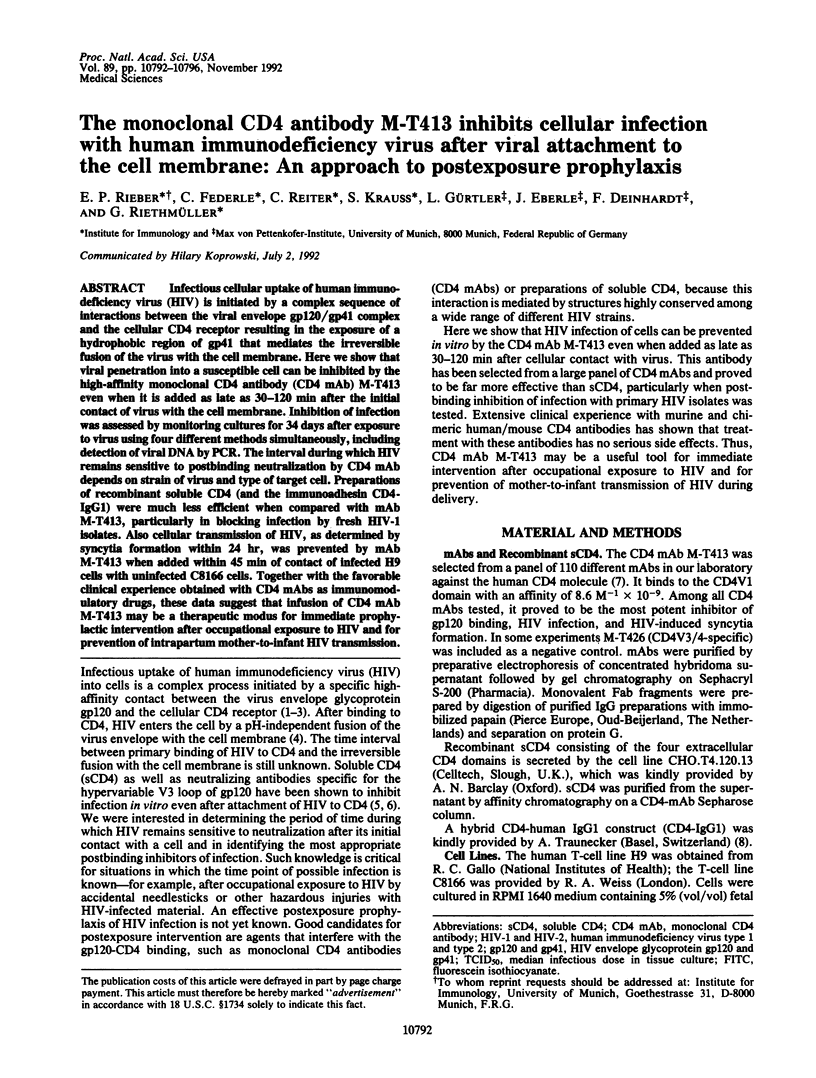
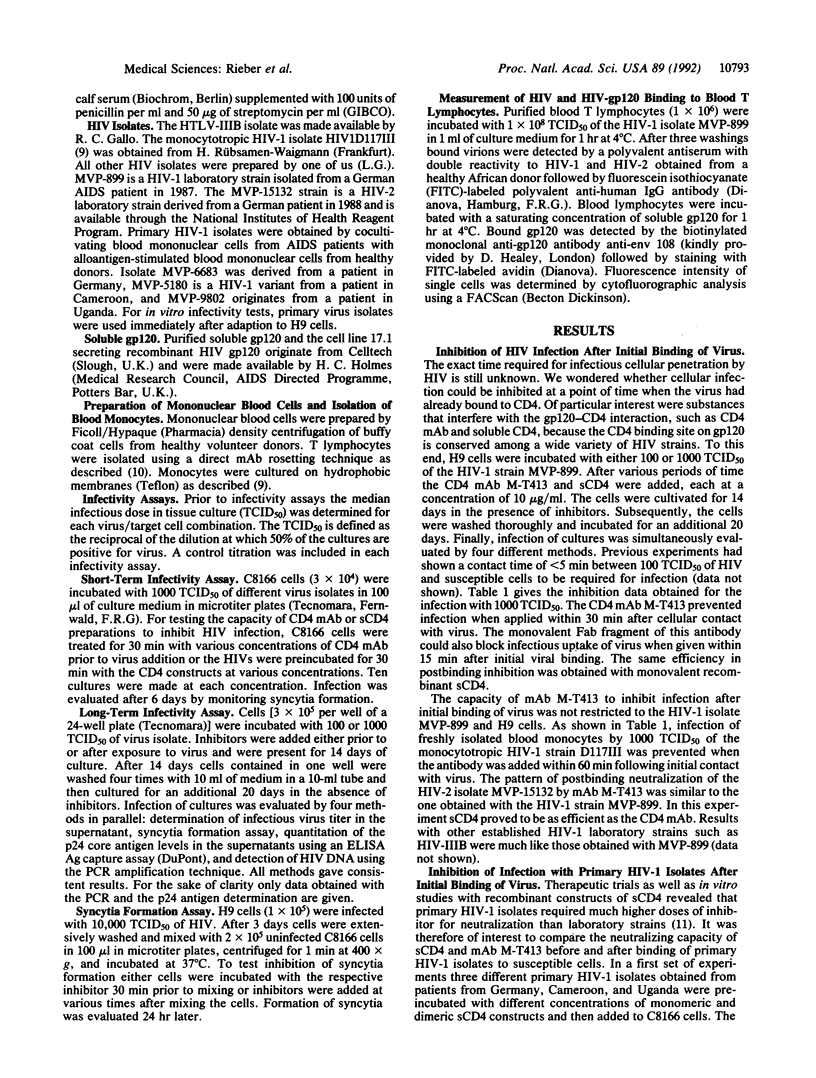
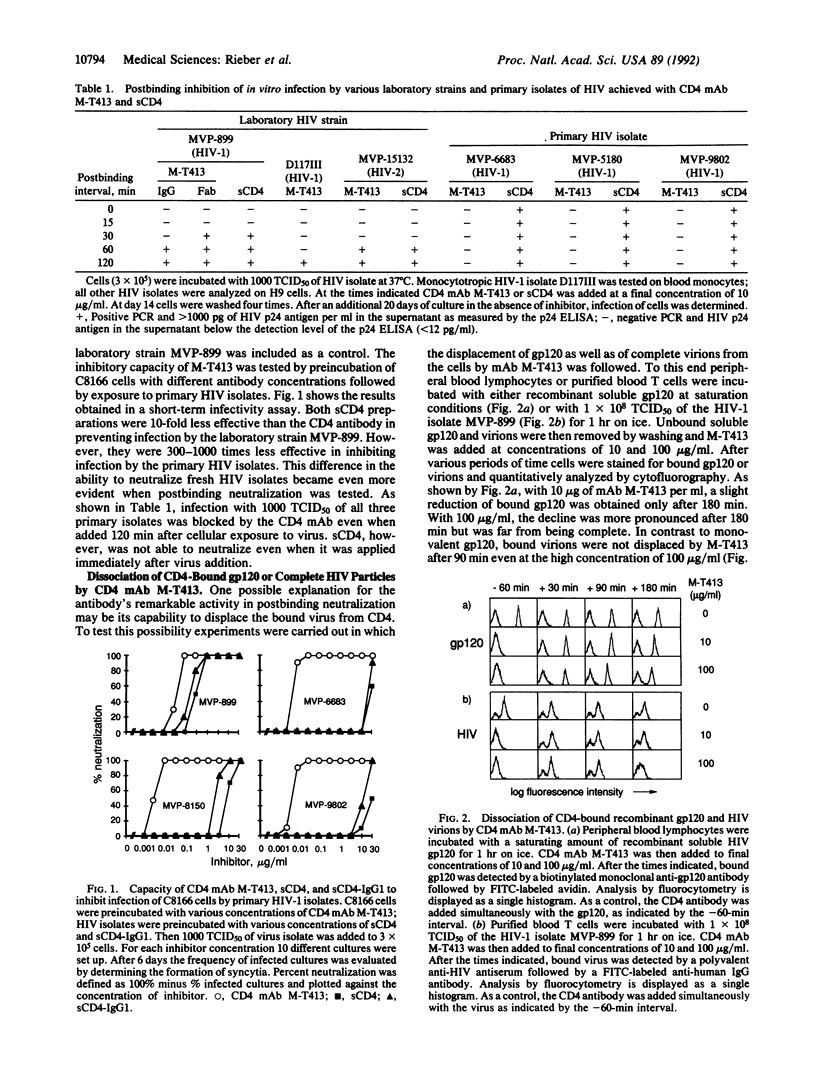
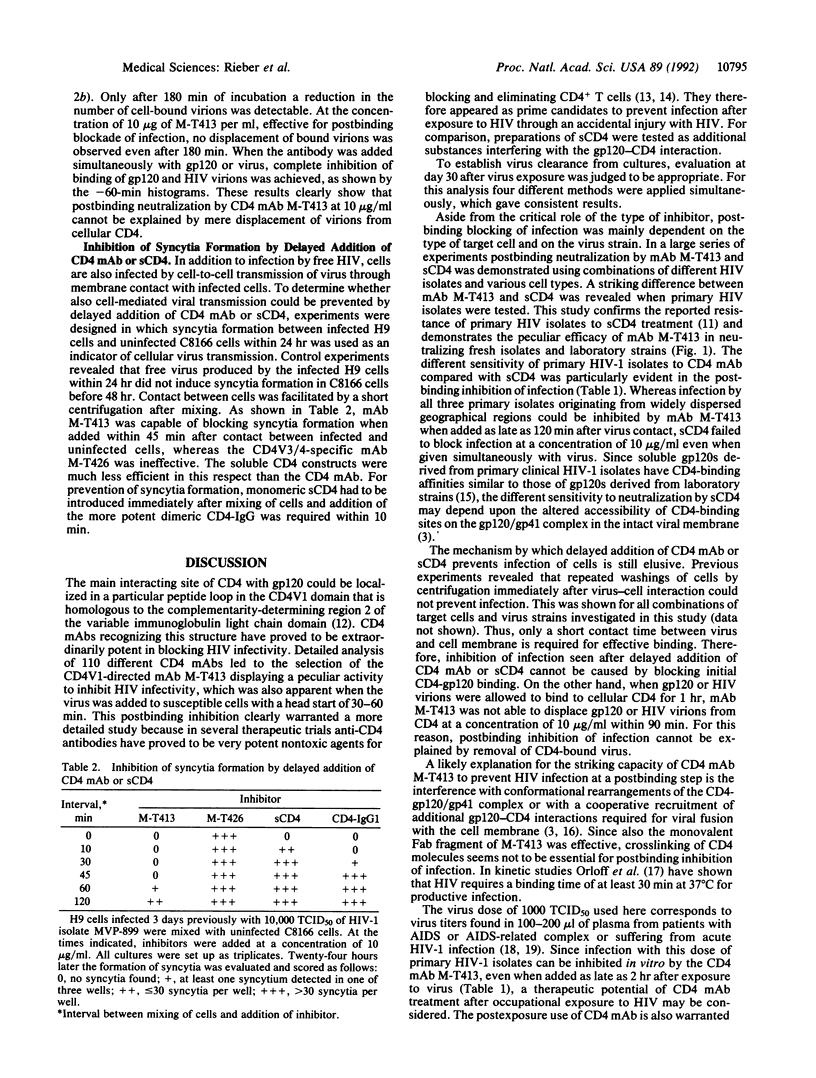
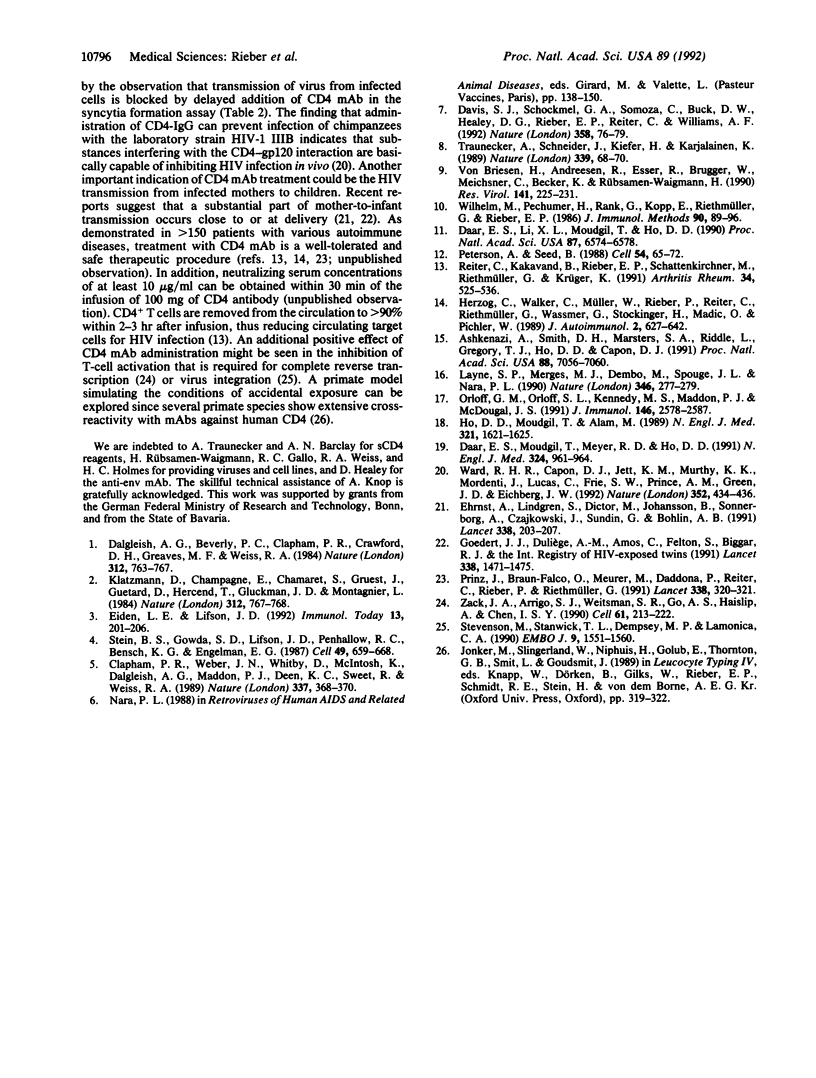
Selected References
These references are in PubMed. This may not be the complete list of references from this article.
- Ashkenazi A., Smith D. H., Marsters S. A., Riddle L., Gregory T. J., Ho D. D., Capon D. J. Resistance of primary isolates of human immunodeficiency virus type 1 to soluble CD4 is independent of CD4-rgp120 binding affinity. Proc Natl Acad Sci U S A. 1991 Aug 15;88(16):7056–7060. doi: 10.1073/pnas.88.16.7056. [DOI] [PMC free article] [PubMed] [Google Scholar]
- Clapham P. R., Weber J. N., Whitby D., McIntosh K., Dalgleish A. G., Maddon P. J., Deen K. C., Sweet R. W., Weiss R. A. Soluble CD4 blocks the infectivity of diverse strains of HIV and SIV for T cells and monocytes but not for brain and muscle cells. Nature. 1989 Jan 26;337(6205):368–370. doi: 10.1038/337368a0. [DOI] [PubMed] [Google Scholar]
- Daar E. S., Li X. L., Moudgil T., Ho D. D. High concentrations of recombinant soluble CD4 are required to neutralize primary human immunodeficiency virus type 1 isolates. Proc Natl Acad Sci U S A. 1990 Sep;87(17):6574–6578. doi: 10.1073/pnas.87.17.6574. [DOI] [PMC free article] [PubMed] [Google Scholar]
- Daar E. S., Moudgil T., Meyer R. D., Ho D. D. Transient high levels of viremia in patients with primary human immunodeficiency virus type 1 infection. N Engl J Med. 1991 Apr 4;324(14):961–964. doi: 10.1056/NEJM199104043241405. [DOI] [PubMed] [Google Scholar]
- Dalgleish A. G., Beverley P. C., Clapham P. R., Crawford D. H., Greaves M. F., Weiss R. A. The CD4 (T4) antigen is an essential component of the receptor for the AIDS retrovirus. Nature. 1984 Dec 20;312(5996):763–767. doi: 10.1038/312763a0. [DOI] [PubMed] [Google Scholar]
- Davis S. J., Schockmel G. A., Somoza C., Buck D. W., Healey D. G., Rieber E. P., Reiter C., Williams A. F. Antibody and HIV-1 gp120 recognition of CD4 undermines the concept of mimicry between antibodies and receptors. Nature. 1992 Jul 2;358(6381):76–79. doi: 10.1038/358076a0. [DOI] [PubMed] [Google Scholar]
- Ehrnst A., Lindgren S., Dictor M., Johansson B., Sönnerborg A., Czajkowski J., Sundin G., Bohlin A. B. HIV in pregnant women and their offspring: evidence for late transmission. Lancet. 1991 Jul 27;338(8761):203–207. doi: 10.1016/0140-6736(91)90347-r. [DOI] [PubMed] [Google Scholar]
- Eiden L. E., Lifson J. D. HIV interactions with CD4: a continuum of conformations and consequences. Immunol Today. 1992 Jun;13(6):201–206. doi: 10.1016/0167-5699(92)90154-Y. [DOI] [PubMed] [Google Scholar]
- Goedert J. J., Duliège A. M., Amos C. I., Felton S., Biggar R. J. High risk of HIV-1 infection for first-born twins. The International Registry of HIV-exposed Twins. Lancet. 1991 Dec 14;338(8781):1471–1475. doi: 10.1016/0140-6736(91)92297-f. [DOI] [PubMed] [Google Scholar]
- Herzog C., Walker C., Müller W., Rieber P., Reiter C., Riethmüller G., Wassmer P., Stockinger H., Madic O., Pichler W. J. Anti-CD4 antibody treatment of patients with rheumatoid arthritis: I. Effect on clinical course and circulating T cells. J Autoimmun. 1989 Oct;2(5):627–642. doi: 10.1016/s0896-8411(89)80002-2. [DOI] [PubMed] [Google Scholar]
- Ho D. D., Moudgil T., Alam M. Quantitation of human immunodeficiency virus type 1 in the blood of infected persons. N Engl J Med. 1989 Dec 14;321(24):1621–1625. doi: 10.1056/NEJM198912143212401. [DOI] [PubMed] [Google Scholar]
- Klatzmann D., Champagne E., Chamaret S., Gruest J., Guetard D., Hercend T., Gluckman J. C., Montagnier L. T-lymphocyte T4 molecule behaves as the receptor for human retrovirus LAV. Nature. 1984 Dec 20;312(5996):767–768. doi: 10.1038/312767a0. [DOI] [PubMed] [Google Scholar]
- Layne S. P., Merges M. J., Dembo M., Spouge J. L., Nara P. L. HIV requires multiple gp120 molecules for CD4-mediated infection. Nature. 1990 Jul 19;346(6281):277–279. doi: 10.1038/346277a0. [DOI] [PubMed] [Google Scholar]
- Orloff G. M., Orloff S. L., Kennedy M. S., Maddon P. J., McDougal J. S. Penetration of CD4 T cells by HIV-1. The CD4 receptor does not internalize with HIV, and CD4-related signal transduction events are not required for entry. J Immunol. 1991 Apr 15;146(8):2578–2587. [PubMed] [Google Scholar]
- Peterson A., Seed B. Genetic analysis of monoclonal antibody and HIV binding sites on the human lymphocyte antigen CD4. Cell. 1988 Jul 1;54(1):65–72. doi: 10.1016/0092-8674(88)90180-8. [DOI] [PubMed] [Google Scholar]
- Prinz J., Braun-Falco O., Meurer M., Daddona P., Reiter C., Rieber P., Riethmüller G. Chimaeric CD4 monoclonal antibody in treatment of generalised pustular psoriasis. Lancet. 1991 Aug 3;338(8762):320–321. doi: 10.1016/0140-6736(91)90464-z. [DOI] [PubMed] [Google Scholar]
- Reiter C., Kakavand B., Rieber E. P., Schattenkirchner M., Riethmüller G., Krüger K. Treatment of rheumatoid arthritis with monoclonal CD4 antibody M-T151. Clinical results and immunopharmacologic effects in an open study, including repeated administration. Arthritis Rheum. 1991 May;34(5):525–536. doi: 10.1002/art.1780340504. [DOI] [PubMed] [Google Scholar]
- Stein B. S., Gowda S. D., Lifson J. D., Penhallow R. C., Bensch K. G., Engleman E. G. pH-independent HIV entry into CD4-positive T cells via virus envelope fusion to the plasma membrane. Cell. 1987 Jun 5;49(5):659–668. doi: 10.1016/0092-8674(87)90542-3. [DOI] [PubMed] [Google Scholar]
- Stevenson M., Stanwick T. L., Dempsey M. P., Lamonica C. A. HIV-1 replication is controlled at the level of T cell activation and proviral integration. EMBO J. 1990 May;9(5):1551–1560. doi: 10.1002/j.1460-2075.1990.tb08274.x. [DOI] [PMC free article] [PubMed] [Google Scholar]
- Traunecker A., Schneider J., Kiefer H., Karjalainen K. Highly efficient neutralization of HIV with recombinant CD4-immunoglobulin molecules. Nature. 1989 May 4;339(6219):68–70. doi: 10.1038/339068a0. [DOI] [PubMed] [Google Scholar]
- Ward R. H., Capon D. J., Jett C. M., Murthy K. K., Mordenti J., Lucas C., Frie S. W., Prince A. M., Green J. D., Eichberg J. W. Prevention of HIV-1 IIIB infection in chimpanzees by CD4 immunoadhesin. Nature. 1991 Aug 1;352(6334):434–436. doi: 10.1038/352434a0. [DOI] [PubMed] [Google Scholar]
- Wilhelm M., Pechumer H., Rank G., Kopp E., Riethmüller G., Rieber E. P. Direct monoclonal antibody rosetting. An effective method for weak antigen detection and large scale separation of human mononuclear cells. J Immunol Methods. 1986 Jun 10;90(1):89–96. doi: 10.1016/0022-1759(86)90388-1. [DOI] [PubMed] [Google Scholar]
- Zack J. A., Arrigo S. J., Weitsman S. R., Go A. S., Haislip A., Chen I. S. HIV-1 entry into quiescent primary lymphocytes: molecular analysis reveals a labile, latent viral structure. Cell. 1990 Apr 20;61(2):213–222. doi: 10.1016/0092-8674(90)90802-l. [DOI] [PubMed] [Google Scholar]
- von Briesen H., Andreesen R., Esser R., Brugger W., Meichsner C., Becker K., Rübsamen-Waigmann H. Infection of monocytes/macrophages by HIV in vitro. Res Virol. 1990 Mar-Apr;141(2):225–231. doi: 10.1016/0923-2516(90)90025-e. [DOI] [PubMed] [Google Scholar]


